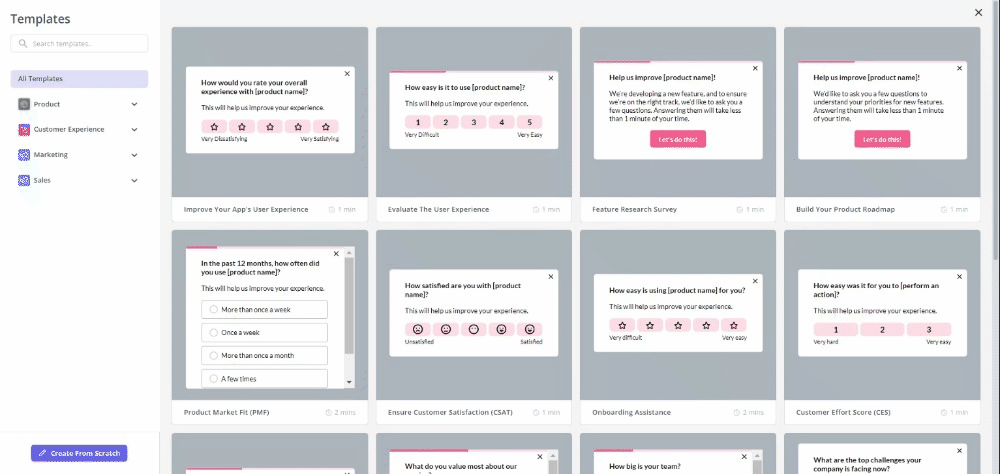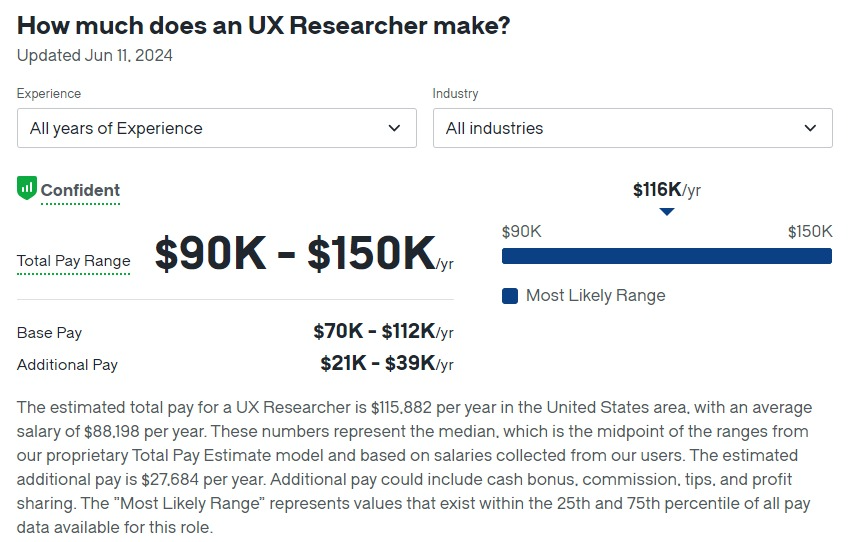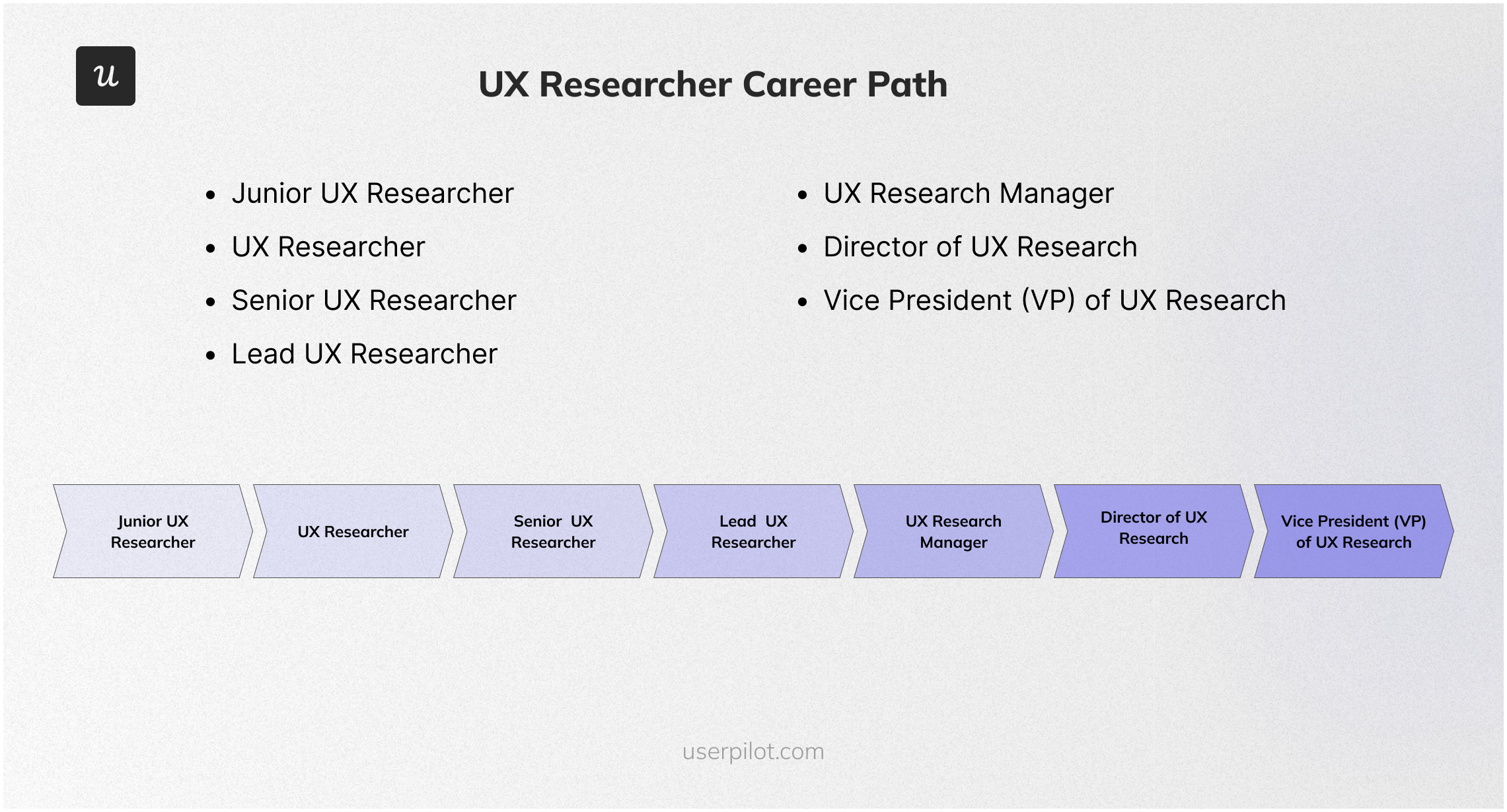![UX Researcher Salary [+ Resources to Advance]](https://blog-static.userpilot.com/blog/wp-content/uploads/2024/07/UX-Researcher-Salary-Resources-to-Advance.png)
Understanding the salary landscape for UX researchers is crucial whether you’re entering the field or looking to advance your career.
In this guide, we’ll provide an overview of typical UX researcher salaries, explore factors that can influence earnings, and share valuable resources to help you progress in your career.
Let’s get started!
Try Userpilot Now
See Why 1,000+ Teams Choose Userpilot

TL;DR
- A UX researcher in SaaS specializes in understanding user behaviors, needs, and motivations through various research methods to inform product design and development.
- A career as a UX researcher can be financially rewarding, with salaries varying based on experience, location, industry, and the company.
- Here’s an example of UX researchers’ salary by experience level:
- Entry-Level (0-2 years): Approximately $60,000 per year, with a range from $43,000 to $87,000.
- Mid-Career (2-5 years): Around $90,000 per year, ranging from $57,000 to $108,000.
- Experienced (5-10 years): About $96,000 per year, with a range from $70,000 to $132,000.
- Late Career (10+ years): Average salary is approximately $106,000 per year.
- To excel as a UX researcher, it’s essential to adopt practices that enhance your ability to gather meaningful insights and communicate them effectively.Here are some best practices:
- Empathize with users
- Communicate clearly
- Collaborate with cross-functional teams
- Stay updated with industry trends
- Iterate based on feedback
- Maintain objectivity
- Document your findings
- Looking into tools for UX researchers? Userpilot is an all-in-one product platform with engagement features and powerful analytics capabilities. Book a demo to see it in action!
What is a UX researcher?
A UX researcher in SaaS specializes in understanding user behaviors, needs, and motivations through various research methods to inform product design and development.
They conduct user interviews, surveys, usability tests, and analyze data to provide actionable insights. These insights help improve user experience and ensure the product meets user expectations and business goals.
In the SaaS industry, UX researchers play a critical role in optimizing software interfaces and features to enhance user satisfaction and engagement.
UX researcher’s main responsibilities
A UX researcher plays a crucial role in understanding user behaviors and needs to inform the design and development of SaaS products.
Here are the main responsibilities and duties of a UX Researcher:
- Conduct User Research: Plan and execute qualitative and quantitative research studies, such as user interviews, surveys, and usability testing.
- Analyze Data: Interpret and synthesize research findings to generate actionable insights and recommendations for product improvements.
- Collaborate with Teams: Work closely with product managers, designers, and developers to integrate research findings into the product development process.
- Create Research Reports: Prepare detailed reports, personas, journey maps, and presentations to effectively communicate insights to stakeholders.
- Advocate for Users: Promote a user-centered design approach within the organization, ensuring user needs and feedback are prioritized.
- Stay Updated: Keep abreast of the latest UX research methods, tools, and industry trends to continuously improve research practices.
- Conduct Competitive Analysis: Analyze competitors’ products to understand market trends and identify opportunities for innovation.
- Facilitate Workshops: Lead workshops and brainstorming sessions to gather input from stakeholders and users.
- Develop Research Plans: Create and manage research plans, timelines, and budgets to ensure projects are completed on schedule.
These responsibilities ensure that UX researchers effectively contribute to the creation of user-centric SaaS products that meet both user and business needs.
How much does a UX researcher make?
A career as a UX researcher can be financially rewarding, with salaries varying based on experience, location, industry, and the company. Here’s a detailed breakdown:
Salary by experience
- Entry-Level (0-2 years): Approximately $60,000 per year, with a range from $43,000 to $87,000.
- Mid-Career (2-5 years): Around $90,000 per year, ranging from $57,000 to $108,000.
- Experienced (5-10 years): About $96,000 per year, with a range from $70,000 to $132,000.
- Late Career (10+ years): Average salary is approximately $106,000 per year.
Salary by location
- San Francisco, CA: $149,315 per year.
- New York, NY: $127,877 per year.
- Austin, TX: $128,333 per year.
- Chicago, IL: $115,598 per year.
Salary by industry
- Technology: Generally, UX researchers in the tech industry can expect salaries ranging from $92,000 to $146,000 per year.
- Finance: Salaries in the financial sector can range from $86,000 to $134,000 annually.
- Healthcare: UX researchers in healthcare might earn between $75,000 and $120,000 per year.
- Retail: The retail sector offers salaries ranging from $70,000 to $110,000 annually.
Highest paying companies
- Google: $120,000 to $230,000 per year.
- LinkedIn: $115,000 to $220,000 per year.
- Meta (Facebook): $110,000 to $210,000 per year.
- Apple: $105,000 to $200,000 per year.
These figures highlight the lucrative nature of a career in UX research, especially within top tech companies and in major metropolitan areas.
UX researcher career path
A career in UX research involves progressing through various roles, each with increasing responsibility and expertise.
Here’s a typical career progression for a UX Researcher:
- Junior UX Researcher: Assists in conducting user research, supports senior researchers, and helps with data collection and analysis. To progress, focus on learning various research methods, gaining practical experience, and building a strong portfolio. Seek feedback from mentors and participate in internships to develop skills.
- UX Researcher: Conducts user research studies, analyzes data, and provides insights to inform product design decisions. Collaborates with designers, developers, and product managers. To advance, take on more complex projects, deepen your understanding of user research methodologies, and develop strong communication skills to present findings effectively.
- Senior UX Researcher: Leads major research projects, mentors junior researchers, and plays a key role in strategic planning and decision-making. Provides detailed insights that significantly impact product development. Enhance leadership skills, contribute to creating research frameworks and methodologies, and build strong relationships with cross-functional teams.
- Lead UX Researcher: Oversees the research team, ensures the quality and consistency of research activities, and aligns research goals with business objectives. Manages multiple projects and collaborates with senior stakeholders. Develop project management skills, drive innovation within the team, and engage in high-level strategic planning. Focus on fostering a user-centered culture within the organization.
- UX Research Manager: Manages the UX research team, coordinates research efforts across projects, and ensures alignment with overall business strategy. Provides leadership and mentorship to the research team. Enhance managerial skills, stay updated with industry trends, and focus on optimizing team performance and research processes. Advocate for the importance of UX research in strategic decisions.
- Director of UX Research: Sets the overall research strategy for the organization, collaborates with top executives, and ensures the integration of research insights into the company’s vision and goals. Oversees all research activities and initiatives. Focus on strategic leadership, expand influence across departments, and drive innovation in research practices. Develop a vision for the future of UX research within the organization.
- Vice President (VP) of UX Research: Responsible for the entire research function within the organization, driving research excellence and contributing to the overall business strategy. Manages a large team of researchers and oversees all research-related activities. Strengthen executive leadership skills, maintain a forward-thinking research vision, and foster a culture of innovation and creativity within the research team.
Each step in this career path builds on the previous one, emphasizing continuous learning, leadership, and strategic thinking to progress to higher levels of responsibility and influence in the field of UX research.
Best practices to be a great UX researcher
To excel as a UX researcher, it’s essential to adopt practices that enhance your ability to gather meaningful insights and communicate them effectively.
Here are some best practices:
- Empathize with Users: Always strive to understand and share the feelings of users. This helps in designing experiences that truly meet their needs and solve their problems. Conduct thorough user interviews and immerse yourself in the user’s environment whenever possible.
- Communicate Clearly: Present your findings in a way that is easily understandable to stakeholders from different backgrounds. Use visual aids like charts, graphs, and personas to make your data more accessible and engaging.
- Collaborate with Cross-Functional Teams: Work closely with designers, developers, product managers, and other stakeholders. Effective collaboration ensures that research insights are integrated into the product development process and that everyone is aligned with user needs.
- Stay Updated with Industry Trends: UX research is a rapidly evolving field. Stay current with the latest research methods, tools, and industry trends by attending conferences, participating in webinars, and reading relevant literature.
- Iterate Based on Feedback: UX research is an iterative process. Use feedback from users and stakeholders to continuously refine your research methods and insights. This helps you make informed design decisions and improve the user experience.
- Maintain Objectivity: Ensure that your research is unbiased and objective. Avoid leading questions and let the data speak for itself. This helps in building trust with stakeholders and ensuring that design decisions are based on solid evidence.
- Document Your Findings: Keep detailed records of your research processes, findings, and insights. This documentation can be invaluable for future projects and for providing context to new team members.
By following these best practices, you can enhance your effectiveness as a UX researcher and contribute to creating user-centric products that meet both user and business needs.
Best resources for UX researchers
To excel as a UX researcher, it’s crucial to stay informed and continuously learn from a variety of resources.
Here are some top recommendations for books, webinars, podcasts, and blogs that every UX researcher should explore.
Best books for UX researchers
Reading books by industry experts can provide deep insights and practical knowledge about UX research and design.
- “The User Experience Team of One” by Leah Buley – Offers practical advice for UX practitioners who are working solo or within small teams.
- “Observing the User Experience” by Elizabeth Goodman, Mike Kuniavsky, and Andrea Moed – A comprehensive guide on conducting user research with practical methodologies.
- “Lean UX” by Jeff Gothelf and Josh Seiden – Focuses on integrating UX with Agile methodologies to improve collaboration and efficiency.
- “Measuring the User Experience” by William Albert and Thomas Tullis – Provides insights into quantitative research methods and metrics for UX.
- “Don’t Make Me Think” by Steve Krug – A classic book on web usability that remains relevant for UX research and design.
Best webinars for UX researchers
Participating in webinars can offer real-time learning and insights from industry experts.
- Userpilot Webinars – Focused on user onboarding, engagement, and product growth.
- NNG (Nielsen Norman Group) Webinars – Provides expert insights on various UX topics, including usability and user research.
- Interaction Design Foundation Webinars – Covers a wide range of UX research and design principles.
- Baymard Institute Webinars – Offers in-depth discussions on UX research for e-commerce usability.
- UX Design Institute Webinars – Provides detailed webinars on UX design principles and career advice.
Best blogs for UX researchers
Following blogs can help you stay updated on the latest trends, tips, and best practices in UX research and design.
- Userpilot Blog – Insights on user onboarding, product growth, and UX design.
- NNG (Nielsen Norman Group) Blog – Research-based articles on UX design and usability.
- Smashing Magazine – Covers a wide range of topics, including UX design, web development, and product management.
- UX Matters – Offers practical advice and insights on various UX research and design topics.
- UX Collective – Community-driven platform with articles on UX research, design, and industry trends.
These resources provide valuable knowledge and practical advice, helping you stay current and excel in your role as a UX Researcher.
Best podcasts for UX researchers
Listening to podcasts is a convenient way to stay informed and inspired by industry leaders while on the go.
- “User Defenders” – Interviews with UX design heroes who share their stories and insights.
- “The UX Intern” – Conversations with UX professionals about their career paths and experiences.
- “UI Breakfast” – Discusses UI/UX design, product strategy, and business with various experts.
- “What is Wrong with UX” – Two experienced UX designers critique current trends and practices.
- “Awkward Silences” – Focuses on user research and customer experience insights.
Best tools for UX researchers
Leveraging the right tools can significantly enhance the efficiency and effectiveness of UX research.
Here are some of the best tools for various aspects of UX research, each tailored for specific use cases:
- Best tool for User Onboarding and Engagement – Userpilot: Userpilot helps UX researchers design and test personalized in-app experiences and onboarding processes. It allows researchers to gather real-time user feedback and insights to improve user engagement and retention.
- Best tool for Project Management – Monday: Monday.com is excellent for organizing and managing research projects. It provides a visual platform that helps UX researchers track tasks, timelines, and collaboration with team members, ensuring that projects stay on schedule.
- Best tool for Product Management – Jira Software: Jira Software is ideal for tracking and managing research tasks, user stories, and sprints. It integrates well with other tools and allows UX researchers to collaborate closely with product teams, ensuring that research findings are effectively incorporated into product development.
- Best tool for Customer Experience – Zendesk: Zendesk helps UX researchers gather and analyze customer feedback and support tickets. This tool provides insights into common user issues and areas for improvement, which can inform user experience design.
- Best tool for Customer Success – ClientSuccess: ClientSuccess is perfect for monitoring and analyzing customer success metrics. UX researchers can use this tool to understand how well users are achieving their goals with the product, providing data to drive improvements in the user experience.
- Best tool for UX/UI Design – Figma: Figma supports real-time collaboration on design projects. UX researchers can use Figma to create wireframes and prototypes, test usability, and gather feedback from users and stakeholders.
- Best tool for UX/UI Design – Sketch: Sketch is a vector graphics editor focused on digital design. It offers numerous plugins and integrations that streamline the design process, making it easier for UX researchers to create and test user interface designs.
- Best tool for Documentation and Collaboration – Confluence: Confluence is great for creating, sharing, and managing research documentation. UX researchers can use it to keep detailed records of research findings, methodologies, and insights, facilitating collaboration and knowledge sharing within the team.
- Best tool for Data Analytics – Tableau: Tableau provides powerful data visualization capabilities. UX researchers can use it to analyze and present research data in an intuitive and visually appealing manner, making it easier to communicate insights to stakeholders.
These tools collectively empower UX researchers to conduct thorough research, manage projects effectively, collaborate with teams, and present data-driven insights that enhance user experience design.
Conclusion
Now that you have a better understanding of the salary range for a UX researcher position, you can take steps to improve your earning potential.
Consider pursuing relevant certifications, developing your skillset, or negotiating effectively during the job offer stage.
Looking into tools for UX researchers? Userpilot is an all-in-one product platform with engagement features and powerful analytics capabilities. Book a demo to see it in action!










